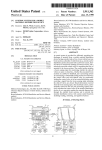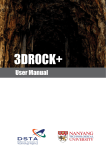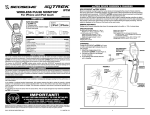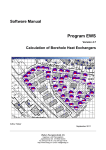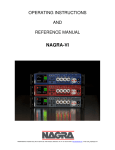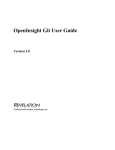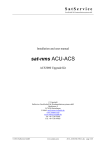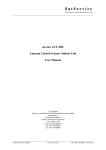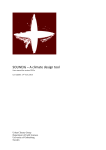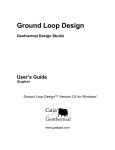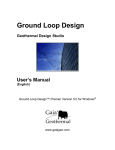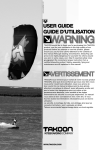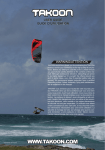Download English
Transcript
nagra
National Cooperative for the
Disposal of Radioactive Waste
TECHNICAL
REPORT 00-02
SANTA – Sensitivity Analysis
of Nuclide Transport Aspects
October 2002
D. McKie and U. Mäder
Hardstrasse 73, CH-5430 Wettingen/Switzerland, Telephone +41-56-437 11 11
nagra
National Cooperative for the
Disposal of Radioactive Waste
TECHNICAL
REPORT 00-02
SANTA – Sensitivity Analysis
of Nuclide Transport Aspects
October 2002
D. McKie1) and U. Mäder 2)
1)
DM Multimedia Ltd., formerly University of Berne, Switzerland
2)
University of Berne, Switzerland
Hardstrasse 73, CH-5430 Wettingen/Switzerland, Telephone +41-56-437 11 11
This report was prepared on behalf of Nagra. The viewpoints presented and conclusions reached are those of
the author(s) and do not necessarily represent those of Nagra.
ISSN 1015-2636
"Copyright © 2002 by Nagra, Wettingen (Switzerland) / All rights reserved.
All parts of this work are protected by copyright. Any utilisation outwith the remit of the copyright law is unlawful
and liable to prosecution. This applies in particular to translations, storage and processing in electronic
systems and programs, microfilms, reproductions, etc."
I
NAGRA NTB 00-02
Summary
The SANTA (Sensitivity Analysis of Nuclide Transport Aspects) program is a simple box
model created to simplify understanding of radionuclide or contaminant transport through a
fractured medium. SANTA is a teaching tool and allows scoping calculations, interpretation of
migration experiments, sensitivity studies, and assists in the development of conceptual models.
The processes acting upon a contaminant explored by SANTA include advection in the main
channel, dispersion in the main channel, linear/non-linear sorption and desorption in the main
channel, diffusion into and out of the rock matrix, sorption and desorption in the rock matrix,
radioactive decay and any combination of the above processes.
Conceptually SANTA uses an array of identical boxes (both in physical dimensions and
geochemical content) to represent a 1-D homogeneous main channel (fracture), with an optional
1-D homogeneous rock matrix, accessed by diffusion, arranged symmetrically about the main
channel and represented by arrays of identical boxes. Transport in the main channel is
implemented by simple movement of the aqueous phase from one box to the next during a set
time, while diffusion into the rock matrix is governed by a discrete approximation of Fick's first
law.
The source term, supplying the first box, is limited to a single contaminant input supplied continuously at a fixed concentration, or as a pulse of finite duration. The status in the last box at the end of
the fracture is continuously recorded and represents the breakthrough curve.
SANTA contains a built-in grapher to display results such as concentration profiles (fracture
and rock matrix) or breakthrough curves, or optionally results can be output to a file.
Code testing focuses on SANTA's implementation of advective flow, diffusion into the rock
matrix (within a bounded and unbounded medium), sorption, dispersion and a combined process
test, and compares SANTA's results with analytical solutions and results from alternative
numerical models. The comparative tests attest sufficient numerical accuracy for the purposes
SANTA was designed for.
SANTA was programmed in a combination of FORTRAN and VISUAL BASIC, retaining the
proven mathematical ability of FORTRAN, while including the user-friendly Windows environment of VISUAL BASIC, with integral graphing and printing capabilities. The program also
features a fully illustrated Help file containing an on-line user manual and reference guide, and
comes with a selection of example input files. SANTA runs on the following operating systems:
Windows 3.x, Windows 95 and Windows NT.
NAGRA NTB 00-02
II
Zusammenfassung
Das Programm SANTA ("Sensitivity Analysis of Nuclide Transport Aspects") ist ein einfaches
Boxmodell, das zum besseren Verständnis des Transports von Radionukliden oder Schadstoffen
in einem geklüfteten Medium entwickelt wurde. SANTA ermöglicht als anschauliches Instrument Überschlagsberechnungen, die Interpretation von Migrationsexperimenten sowie Sensitivitätsstudien und ist bei der Entwicklung von konzeptuellen Modellen behilflich.
Dabei berücksichtigt SANTA folgende Prozesse, die auf einen Schadstoff einwirken: Advektion, Dispersion, lineare/nicht-lineare Sorption und Desorption – jeweils entlang des bevorzugten Transportwegs – Diffusion in die und aus der Gesteinsmatrix, Sorption und Desorption in
der Gesteinsmatrix, radioaktiver Zerfall sowie jede Kombination dieser Prozesse.
In SANTA wird eine Reihe identischer Boxen (sowohl bezüglich physikalischer Dimensionen
als auch geochemischem Inhalt) konzeptionell zur Darstellung eines eindimensionalen bevorzugten Transportwegs (Kluft) verwendet. Als Option kann eine eindimensionale homogene
Gesteinsmatrix gewählt werden, die für Diffusion zugänglich und symmetrisch um die Kluft
angeordnet ist und durch Reihen identischer Boxen dargestellt wird. Transport in der Hauptkluft
wird durch einfache Verschiebung der wässrigen Phase von einer Box zur nächsten während
einer bestimmten Zeit durchgeführt, während die Diffusion in die Gesteinsmatrix durch eine
diskrete Annäherung an das Erste Fick'sche Gesetz gesteuert wird.
Der Quellterm für die erste Box beschränkt sich auf die Zugabe eines einzigen Schadstoffs und
erfolgt kontinuierlich mit einer festgelegten Konzentration oder als Puls einer bestimmten
Dauer. Der Zustand in der letzten Box am Ende der Kluft wird kontinuierlich erfasst und entspricht der Durchbruchskurve.
SANTA verfügt über ein integriertes Grafikprogramm, um die Resultate als Konzentrationsprofile (Kluft und Gesteinsmatrix) oder Durchbruchskurven darzustellen, eine weitere Möglichkeit
besteht in der Ausgabe der Resultate in einem File.
Der Test des Computercodes richtet sich nach den in SANTA implementierten Prozessen, wie
advektivem Fluss, Diffusion in die Gesteinsmatrix (innerhalb eines begrenzten und unbegrenzten Mediums), Sorption, Dispersion sowie einem kombinierten Prozesstest, und vergleicht die
Resultate von SANTA mit analytischen Lösungsansätzen und Ergebnissen alternativer numerischer Modelle. Die vergleichenden Tests zeigen eine ausreichende numerische Genauigkeit für
die in SANTA vorgesehenen Anwendungen.
SANTA wurde in einer Kombination aus FORTRAN und VISUAL BASICS programmiert und
vereint damit die bewährten mathematischen Fähigkeiten von FORTRAN mit dem benutzerfreundlichen Windows-Programm VISUAL BASICS und all dessen integrierten grafischen und
Druckmöglichkeiten. Das Programm weist ebenfalls ein vollständig erläuterndes Help-File auf,
das on-line ein Benutzer- und Referenzhandbuch mit einer Reihe von Beispielen zu EingabeFiles enthält. SANTA erfordert folgende Betriebssysteme: Windows 3.x, Windows 95 und
Windows NT.
III
NAGRA NTB 00-02
Résumé
Le programme SANTA (Sensitivity Analysis of Nuclide Transport Aspects) est un modèle simple de type boîtes successives destiné à la compréhension du transport de contaminants en milieu fracturé. Il s'agit d'un outil d'enseignement permettant des calculs étendus, l'interprétation
d'expériences de migration, des études de sensibilité et l'assistance au développement de modèles conceptuels.
Les processus agissant sur un contaminant et pris en compte par SANTA comprennent la
convection dans le conduit principal, la dispersion dans le conduit principal, l'adsorption et la
désorption linéaires/non linéaires dans le conduit principal, la diffusion dans et de la matrice
rocheuse, l'adsorption et la désorption dans la matrice rocheuse, la désintégration radioactive et
toute combinaison des processus mentionnés.
Le principe de SANTA est basé sur l'utilisation d'une série de boîtes identiques (dans leurs dimensions physiques et leur contenu géochimique) pour représenter un conduit principal homogène unidimensionnel (fracture), et de manière optionnelle une matrice rocheuse homogène
unidimensionnelle accessible par diffusion; cette matrice est disposée d'une manière symétrique
autour du conduit principal et représentée par des séries de boîtes identiques. Le transport dans
le conduit principal est dicté par le simple mouvement de la phase aqueuse d'une boîte à la suivante durant un laps de temps donné, tandis que la diffusion dans la matrice rocheuse est régie
par une approximation discrète de la première loi de Frick.
Le terme source, alimentant la première boîte, se limite à une injection simple du contaminant
de manière continue et à concentration fixe, ou à une impulsion de durée limitée. L'état dans la
dernière boîte, à l'autre extrémité de la fracture, est enregistré et représente la courbe de restitution.
SANTA possède un générateur de graphes incorporé pour la représentation des résultats tels que
des profils de concentration (dans la fracture et la matrice rocheuse) ou des courbes de restitution; de manière optionnelle, les résultats peuvent être enregistrés dans un fichier.
Le contrôle du programme de SANTA a été focalisé sur la simulation de l'écoulement convectif,
de la diffusion dans la matrice rocheuse (milieu limité ou non), de l'adsorption, de la dispersion
et de la combinaison de ces processus. Ce contrôle permet de comparer les résultats de SANTA
avec les solutions analytiques et les résultats d'autres modèles numériques. Les tests comparatifs
ont révélé une précision numérique suffisante pour les utilisations auxquelles SANTA est destinée.
SANTA a été programmé en combinant le FORTRAN avec le VISUAL BASIC, en raison des
capacités mathématiques éprouvées du FORTRAN et de l'environnement Windows convivial du
VISUAL BASIC, comprenant des graphiques intégrés et des facilités d'impression. Le programme fournit aussi un fichier d'aide abondamment illustré, ainsi qu'un manuel et un guide de
référence en ligne ; une série d'exemples de fichiers d'entrée est également fournie. SANTA
fonctionne sur les environnements suivants: Windows 3x, Windows 95 et Windows NT.
V
NAGRA NTB 00-02
List of Contents
Summary
................................................................................................................................... I
Zusammenfassung.........................................................................................................................II
Résumé
.................................................................................................................................III
List of Contents .............................................................................................................................V
List of Figures ............................................................................................................................ VII
1
Introduction ............................................................................................................ 1
2
The Box Model ........................................................................................................ 2
2.1
Overview of the SANTA box model ........................................................................ 4
3
Advection................................................................................................................. 5
4
Diffusion .................................................................................................................. 7
5
Sorption ................................................................................................................. 11
5.1
Diffusion with Sorption in the rock matrix............................................................. 13
6
Dispersion .............................................................................................................. 15
7
Code Testing.......................................................................................................... 18
7.1
Advective flow ....................................................................................................... 18
7.2
Diffusion................................................................................................................. 20
7.2.1
Diffusion into the Rock Matrix from the Main Channel ........................................ 20
7.2.2
Diffusion into the Rock Matrix (with fixed boundary) from the Main
Channel................................................................................................................... 25
7.2.3
Diffusion into the Main Channel from the Rock Matrix ........................................ 29
7.3
Sorption/Dispersion ................................................................................................ 32
7.4
Diffusion with Sorption .......................................................................................... 36
7.5
Sorption, dispersion and radioactive decay ............................................................ 39
8
Worked Example .................................................................................................. 42
8.1
Worked example 1, advection ................................................................................ 42
8.2
Worked example 2, advection/dispersion and sorption .......................................... 43
8.3
Worked example 3, advection/dispersion, sorption and diffusion.......................... 44
8.4
Worked example 4, advection/dispersion, sorption and diffusion with
sorption ................................................................................................................... 45
9
Concluding remarks on accuracy and limitations ............................................. 46
NAGRA NTB 00-02
VI
10
Coding of SANTA................................................................................................. 48
11
Acknowledgments ................................................................................................. 50
12
References.............................................................................................................. 51
APPENDIX A: Quick start – run something now................................................................ A-1
VII
NAGRA NTB 00-02
List of Figures
Fig. 2.1:
A box derived from a representation of reality......................................................... 2
Fig. 2.2:
Typical system constructed from boxes and comparative 3-D simplification
of reality.................................................................................................................... 3
Fig. 3.1:
Simple advection system .......................................................................................... 5
Fig. 3.2:
Advective flow ......................................................................................................... 5
Fig. 3.3:
Predicted distribution of contaminant after 5 cycles ................................................ 6
Fig. 3.4:
Predicted distribution of contaminant after 10 cycles .............................................. 6
Fig. 3.5:
Predicted distribution contaminant after 15 cycles................................................... 6
Fig. 4.1:
Representation of diffusion in the rock matrix ......................................................... 7
Fig. 4.2:
Definition of diffusion length ................................................................................... 8
Fig. 4.3:
Consecutive build-up diffusing contaminant in the rock matrix ............................ 10
Fig. 5.1:
Representation of sorption in the box model .......................................................... 11
Fig. 7.1:
Development of SANTA concentration profile for the rock matrix adjacent
to main channel box 1 (time period 0.05 to 1 hour) ............................................... 22
Fig. 7.2:
Development of analytical concentration profile for the rock matrix adjacent
to main channel box 1 (time period 0.05 to 1 hour) ............................................... 23
Fig. 7.3:
Cumulative mass transfer into the rock matrix at the end of each time step
(0.05 hours), produced with SANTA and analytical solution ................................ 24
Fig. 7.4:
Incremental mass transfer per time step calculated by SANTA and predicted
by analytical solution.............................................................................................. 25
Fig. 7.5:
Analytical concentration profile for the unbounded infinite half-space
(after 0.05, 12.05 and 23.45 hours)......................................................................... 26
Fig. 7.6:
Analytical concentration profile for a bounded system with a boundary after
the 10th box (after 0.05, 12.05 and 23.45 hours)..................................................... 27
Fig. 7.7:
Concentration profile calculated by SANTA
(after 0.05, 12.05 and 23.45 hours)......................................................................... 27
Fig. 7.8:
Cumulative mass transfer across the main channel/rock matrix interface
plotted every 12 cycles; Analytic A: analytical solution for the infinite halfspace, Analytic B: analytical solution with a boundary after the 10th box and
SANTA data ........................................................................................................... 28
Fig. 7.9:
Mass transfer across the main channel/rock matrix interface plotted every 12
cycles; Analytic A: analytical solution for the infinite half-space, Analytic B:
analytical solution with a boundary after the 10th box, SANTA data and
Difference between SANTA and Analytic B ......................................................... 29
Fig. 7.10:
SANTA concentration profile (after pulse) ............................................................ 30
Fig. 7.11:
Analytical concentration profile (after pulse)......................................................... 31
Fig. 7.12:
SANTA / Analytical mass transfer from rock matrix............................................. 32
Fig. 7.13:
SANTA /Analytical concentration profile (for Kd = 0.1 with 45 boxes) ............... 34
NAGRA NTB 00-02
VIII
Fig. 7.14:
SANTA / Analytical concentration profile (for Kd = 0.1 with 13 boxes) .............. 34
Fig. 7.15:
SANTA / Analytical concentration profile (for Kd = 6.6E-3 with 10 boxes) ........ 35
Fig. 7.16:
SANTA / Analytical concentration profile at 16 cycles (Kd = 0.1) ....................... 35
Fig. 7.17:
SANTA / Analytical concentration profile at 50 cycles (Kd = 0.1) ....................... 36
Fig. 7.18:
SANTA concentration profile for contaminant ...................................................... 38
Fig. 7.19:
Analytical profile.................................................................................................... 38
Fig. 7.20:
Analytical difference .............................................................................................. 39
Fig. 7.21:
SANTA / PICNIC breakthrough curve including advection, dispersion and
sorption ................................................................................................................... 40
Fig. 7.22:
SANTA / PICNIC (B) breakthrough curve including advection, dispersion,
sorption and decay .................................................................................................. 41
Fig. 10.1:
Comparison of coding methods .............................................................................. 48
1
1
NAGRA NTB 00-02
Introduction
SANTA (Sensitivity Analysis of Nuclide Transport Aspects) was created primarily as a
teaching tool to simplify understanding of radionuclide transport through the geosphere, and
secondly, as a simple scoping tool to quickly evaluate the effect of a range of retardation
mechanisms on contaminant transport. It is intended that SANTA's transparent and clear
implementation of the processes will enable the user a basic insight into the calculations not
afforded by more complex methods. SANTA is designed to treat a single contaminant species
without consideration of complex chemical interaction.
To achieve this, SANTA employs the "box modeling" approach which, very simply, breaks
down the ground water flow path into a linked series of identical boxes with the same physical
properties (i. e. porosity, rock chemistry etc.). It is inside each of these boxes that the processes
causing partitioning of the contaminant between the rock and ground water phases (i.e. sorption)
can be simulated in a simple, transparent manner. The process of advection is implemented
simply by moving the mobile ground water phase of a box into the next box down stream.
One main advantage of the box modeling approach is the clearly defined physical approach that
results in an easily visualised system of boxes and their inter-actions with each other. The user
can define all the relevant parameters used in the code. These parameters are fixed physical
dimensions and properties of the fracture material being modeled. All other parameters are
derived from these simple input parameters. SANTA, therefore does not need the input of a
large amount of fit, or constant of proportionality factors. During the testing stages (documented
later) any errors or limitations introduced by this box model approach are clearly shown.
This simple approach contrasts strongly with some of the alternative methods, such as solving
complex non-linear sets of partial differential equations (PDEs) describing coupled reaction and
transport in a multicomponent system by using finite difference techniques. The methods to
solve these sets of PDEs themselves introduce discretisation, truncation and stability errors.
These errors are usually minimised by carefully selecting the grid spacing and time stepping to
be used, but without care an error term can quickly swamp the calculations. This approach,
therefore, requires the understanding of mathematical methods unfamiliar to many potential
users of the code and, as stated earlier, it is the intention for the user to become involved in the
actual methodology employed to solve the problem not simply to find a numerical solution to
the problem.
It must be stated that in either case, many of the values used for input terms are themselves
subject to much debate and uncertainty. Without a complete examination of the flow system, a
conceptual model is used for the internal properties of the system. This limitation must be kept
in mind when quoting the apparent accuracy of results produced by numerical codes in general.
To enable the user to avoid the long learning and familiarisation process necessary to use complex models, SANTA was coded to perform simple transport/retardation calculations quickly
and easily on a standard PC using the familiar environment offered by Microsoft Windows.
SANTA's integrated environment contains its own input files, graphing abilities and output
options thus enabling easy, quick desk-top scoping.
NAGRA NTB 00-02
2
2
The Box Model
Direction of flow
The aim of SANTA is to model the transport and retardation of a tracer in a fractured rock using
a simple box model to represent the ground water flow path. The basic principle of a box model
is that this ground water flow path is divided into a number of identical compartments or boxes
(Fig. 2.1). Each of these boxes is a simplified representation of the more complex reality, with
all boxes in the main fracture having identical dimensions and the same internal properties (i.e.
porosity, rock density) and volume. A simple array of these boxes can be constructed to represent a water flowing fracture in one dimension, and, with an additional array of side boxes, a
rock matrix can be represented (Fig. 2.2). These boxes contain distinct phases ; namely the
ground water and the rock with which it is in contact. The water phase (aqueous species) is the
mobile part and can move through the series of boxes carrying with it any tracer, while the rock
(solid species) is stationary and remains permanently in a given box, retaining any retarded
material. A source supplies the first box of the fracture while the contents of the last box of the
fracture leave the system.
C
B
A
B
Simplified sketch of a water conducting fracture
B
A
B
Simplified representation
A = Water conducting fracture
B = Matrix or hostrock alteration
Aqueous Species
Solid Species
Simplified Box
Fig. 2.1:
A box derived from a representation of reality
3-D Representation
3
NAGRA NTB 00-02
A System Built up using basic
boxes as building blocks
Depth of matrix
Water
Rock
Accessible
Rock Matrix
Main Channel
Accessible
Rock Matrix
Accessible
Rock Matrix
Main Channel
Accessible
Rock Matrix
Fig. 2.2:
Typical system constructed from boxes and comparative 3-D simplification of
reality
In addition to the boxes used to represent the main flow path, the rock matrix adjacent to a
fracture can be represented by additional boxes with different internal properties and volume
than the fracture to represent rock matrix which is accessible by diffusion from the fracture. A
typical setup with an advective channel and a diffusive rock matrix is shown in Fig. 2.2 along
with a simplification of a water flowing fracture.
Note: For reasons of simplicity the rock matrix boxes are shown here with the same dimensions as the
main channel boxes. In most cases the rock matrix boxes will have dimensions different than the
main channel boxes.
NAGRA NTB 00-02
2.1
4
Overview of the SANTA box model
The geometry outlined above is restricted to the following elements:
•
A 1-D homogeneous main-channel (fracture) represented by an array of identical boxes
(both in dimension and content).
•
A 1-D rock matrix (optional) accessable by diffusion arranged symmetrically about the
main channel and represented by arrays of identical boxes (both in dimension and content).
A single tracer source is input to the first main channel box. The source can be:
1. supplied continuously at a fixed (initial) concentration, or
2. supplied as a pulse of finite duration at a fixed concentration.
The processes simulated by SANTA include:
•
Advection in the main channel
•
Dispersion in the main channel
•
Sorption and desorption in the main channel
•
Diffusion into and out of the rock matrix
•
Sorption and desorption in the rock matrix
•
Radioactive decay
•
Any combination of the above processes.
5
3
NAGRA NTB 00-02
Advection
SANTA represents advection as the physical movement of a contaminant, in this case using
water as the transport medium. In the very simple case of advection along a single flow path, a
linear sequence of identical boxes may be used (Fig. 3.1).
Main Channel
One cycle
Water
Rock
Input source
Fig. 3.1:
Simple advection system
The SANTA code simulates the movement of water by moving the aqueous contents of box n to
box n + 1 (Fig. 3.2). The contents that were in the last box leave the system, while the input to
the first box comes from the source term outside the system (being either background water or
an injected pollutant). The process of moving water between boxes and subsequent solute
redistribution is called a cycle, a measurement of time used within SANTA. Thus SANTA
transports the water volume in each box to the next box in one of these cycles to simulate
advection. The time taken for one of these cycles is the residence time a solute remains in a box
and is used in any calculations that are time dependent.
Initial Distribution
D
C
B
Box n
Box n + 1
Box n + 2
A
Direction of advective flow
Distribution after advection (1 cycle)
E
D
C
Box n
Box n + 1
Box n + 2
Note: A leaves the system, E is input to the system
Fig. 3.2:
Advective flow
B
NAGRA NTB 00-02
6
In SANTA's representation of advection the aqueous phase moves forward one box per cycle.
With a constant input of tracer and considering only advection (no dispersion, retardation etc.)
the development of the predicted distribution profile is shown in Fig. 3.3 after 5 cycles.
1
Normalised
concentration
5
Box number
Fig. 3.3:
10
Predicted distribution of contaminant after 5 cycles
The predicted distribution profile is shown in Fig. 3.4 after 10 cycles.
1
Normalised
concentration
5
Box number
Fig. 3.4:
10
Predicted distribution of contaminant after 10 cycles
If the input of tracer is switched off after the 10th cycle and the process of advection allowed to
continue until the 15th cycle the predicted distribution profile would be as illustrated in Fig. 3.5.
This type of box model leads to a numerically accurate description of plug flow (square pulse).
1
Normalised
concentration
5
Box number
Fig. 3.5:
Predicted distribution contaminant after 15 cycles
10
7
4
NAGRA NTB 00-02
Diffusion
To represent rock matrix diffusion SANTA uses an array of boxes extending perpendicularly in
the horizontal plane, adjacent to the main channel. This is illustrated in Fig. 4.1 below (with a
depth of diffusion of 2 boxes) and with the rock matrix boxes having the same proportions as
the main channel boxes for clarity only (i. e. this need not be so). Diffusion in the main channel
is omitted (it is assumed that advection will dominate transport in the main channel). In general,
the boxes of the rock matrix will usually be much smaller than the main channel boxes due to
the shorter distance the diffusive flux can achieve within a cycle compared to the advective
flow.
Water
Rock
Rock Matrix
2.
Main Channel Advective Flow
2.
1.
1. Input
2. Matrix Diffusion
Fig. 4.1:
Main Channel
Representation of diffusion in the rock matrix
Diffusive transport into the rock matrix boxes is represented by Fick's first law (CRANK et al.
1981):
Flux = −
dC
D
dx
where D is the coefficient of diffusion and
(Eq. 4.1)
dC
dx
is the concentration (C) gradient in the
x direction. If this gradient is over a layer of thickness l, then:
Flux = D
C1 − C 2
l
(Eq. 4.2)
where flux is defined from box I to box II (which lie perpendicular to the main channel) with
concentrations C1 and C2 respectively, and positive towards lower concentration.
NAGRA NTB 00-02
8
For the mass balance equation, the mass transferred between boxes (MT) is defined:
MT = Flux A φ tc
(Eq. 4.3)
where A is the contact area (area of rock matrix box parallel to main channel), φ is the porosity
of the medium in which diffusion occurs and tc the time of one cycle.
To calculate the diffusion length l, the following equation was used: l = 2 D ⋅ tc
At time tc, 90 % of the mass of the tracer will be contained in the matrix from depth 0 to depth l
(Fig. 4.2). Therefore the full depth of the rock matrix will be l times the number of rock matrix
boxes (l · NoSideBoxes).
Concentration
90 %
2 Sqrt (Dt c)
Fig. 4.2:
Distance
Definition of diffusion length
NOTE: At present the code defaults to the depth of 10 rock matrix boxes. This can be modified to more
rock matrix boxes, i.e., enable longer run times. As the diffusion length is proportional to the
root of time, and the duration of the injection pulse is usually small compared to the duration of
advective flow, it might be possible to fix the maximum number of rock matrix boxes at a
number << 100. At present the maximum number of rock matrix boxes allowed by the code is
20.
With the Flux = D
C1 − C 2
l
and Mass Transfer (MT) = D
C1 − C 2
A ⋅ tc ⋅ φ ,
l
this gives:
MT =
D ⋅ A ⋅ φ ⋅ t c ⋅ (C1 − C 2 )
2 ⋅ D ⋅ tc
for a cycle
(Eq. 4.4)
9
NAGRA NTB 00-02
As all the factors except C1 and C2 will be constant throughout a run, Equation 4.4 may be
formulated as:
MT = KDiff (C1 − C 2) ; with KDiff =
D ⋅ A ⋅ φ ⋅ tc
2 D ⋅ tc
With the mass transfer known for a cycle, the concentrations C1 and C2 can be updated
accordingly. Care must be taken when moving a mass of contaminant to, or from, a main
channel box to a rock matrix box due to the possible different volumes of these boxes. If C1 is
the concentration in the main channel box (1), and C2 is the concentration in the first rock
matrix box (I), the updated concentrations can be calculated as follows:
With C1 > C2;
C1 =
C1 ⋅ MBWaterVolume − KDiff ⋅ ( C1 − C 2 )
MBWaterVolume
(Eq. 4.5)
C2 =
C 2 ⋅ RMWaterVolume + KDiff ⋅ (C1 − C 2 )
RMWaterVolume
(Eq. 4.6)
where MBWaterVolume is the volume of water in the fracture box and RMWaterVolume is the
volume of water in the rock matrix box.
In representing diffusion the code assumes that the initial incoming pulse to the first rock matrix
box (I) off the first main channel box (1) can only travel the distance of one box per cycle. Thus,
with a constant injection, the tracer will reach the second rock matrix box (II) in the second
cycle (illustrated below, Fig. 4.3, with a depth of diffusion of 6 boxes). This prevents a pulse
reaching the furthest rock matrix box in the first cycle. The code, at this stage, does not consider
diffusion between different rock matrix columns, i. e. no diffusion occurs between any rock
matrix boxes adjacent to Box 1 and any rock matrix boxes adjacent to Box 2. Diffusion occurs
perpendicular to the main channel.
NAGRA NTB 00-02
10
I
II
III
IV
V
VI
II
Cycle 1.
III IV
V
VI
1
2
3
I
1
Depth of diffusion: 6 boxes
2
3
Direction of
advection
I
II
Cycle 2.
III IV
V
VI
1
2
3
Cycle 3.
Direction of diffusion
Fig. 4.3:
Consecutive build-up diffusing contaminant in the rock matrix
11
5
NAGRA NTB 00-02
Sorption
The process of sorption can occur in every box in the system and is the first process that
SANTA calculates in a box on the incoming fluid (followed by diffusion into the rock matrix, if
selected). The concept underpinning the sequence of events relies on sorption being relatively
fast compared to diffusion. This is outlined in Fig. 5.1 below, with the (possible) order of
events:
Water
Rock
Rock Matrix
1.
1.
1.
1.
3.
3.
2.
1.
4.
2.
3.
2.
1.
4.
1. Input
2. Sorption
3. Matrix Diffusion
4. Sorption in rock matrix boxes
Fig. 5.1:
2.
2.
Main Channel
2.
Representation of sorption in the box model
In the model sorption is described by the general Freundlich equation (APPELO & POSTMA
1993):
Cr = α ⋅ Cwβ
where:
Cr :
Cw :
α:
β:
(Eq. 5.1)
Concentration in the rock
Concentration in the water
[kg/kg]
[kg/m3]
Freundlich alpha for sorption
Freundlich beta for sorption
[m3/kg]
[-]
This equation describes the relationship between the concentration in the rock and the
concentration in the water for a contaminant, while α and β are known parameters whose values
have been previously derived experimentally. Therefore the concentrations in the water and
rock can be determined with Equation 5.1. For most cases in natural environments β is smaller
than one.
NAGRA NTB 00-02
12
Initially an inventory of the mass of contaminant in the box is taken as follows:
INV = WaterVolume ⋅ Cw + Rockmass ⋅ Cr
(Eq. 5.2)
Replacing Cr ;
INV = WaterVolume ⋅ Cw + RockMass ⋅ α ⋅ Cwβ
(Eq. 5.3)
It is now possible to solve for Cw . There are three methods to solve Equation 5.3 depending on
the value of β. The first case is if β = 1, producing a linear relationship between Cw and Cr . For
this case α = Kd and Equation 5.3 becomes:
INV = WaterVolume ⋅ Cw + RockMass ⋅ Kd ⋅ Cw
(Eq. 5.4)
Making Cw the subject of the equation results in:
Cw =
INV
WaterVolume + RockMass ⋅ Kd
(Eq. 5.5)
Equation 5.5 is now immediately solvable as all the parameters are known. By back substitution
into Equation 5.1, the new value for Cr can be calculated. The updated value for concentration
in the water is the value that is now available to control diffusion into the rock matrix, where the
process of sorption occurs again.
The remaining methods are used if β ≠ 1. In this case Equation 5.3 is non-linear and requires a
different approach. One such approach is the use of the Newton-Raphson one-dimensional rootfinding method. This method enables the honing in on the root, or numerical solution, to
Equation 5.5 to a desired accuracy. Algebraically, the method derives from the standard Taylor
series expansion of a function in the neighbourhood of a point:
f ( x + δ ) ≈ f ( x ) + f ′( x ) ⋅ δ +
f ′′( x ) 2
⋅ δ + .......
2
(Eq. 5.6)
For small enough values of δ, and for well behaved functions, the terms beyond the linear term
can be ignored, hence:
f ( x + δ ) = 0 implies δ = −
f (x )
f ′′( x ) 2
with an overall error of ≈
⋅δ
f ′( x )
2
13
NAGRA NTB 00-02
This gives rise to the Newton-Raphson formula:
xi +1 = xi −
f ( xi )
where xi = initial guess, and xi +1 = improved estimate
f ′′(xi )
This Newton-Raphson formula can now be used iteratively until some defined accuracy is
obtained. In the SANTA code this accuracy is input by the user. If the relative accuracy is
defined to be 0.01, then if xi − xi+1 ≤ ±0. 01 × xi+1 the iterative process is halted and the value of
Cw is taken to be xi +1 .
Re-arranging Equation 5.1 to make Cw the subject:
1
æC öβ
Cw = ç r ÷
èα ø
1
æ 1 öβ
Defining A = ç ÷
èα ø
and B =
(Eq. 5.7)
1
Equation 5.4 becomes:
β
INV = WaterVolume ⋅ A ⋅ CrB + RockMass ⋅ Cr
(Eq. 5.8)
which is equivalent to:
f (C r ) = WaterVolume ⋅ A ⋅ C r + RockMass ⋅ C r − INV = 0
B
(Eq. 5.9)
The first derivative becomes:
f ′(C r ) = B ⋅ WaterVolume ⋅ A ⋅ C r
B −1
+ RockMass
(Eq. 5.10)
By putting B = 1 in Equation 5.9 an initial estimate of Cr can be obtained. Once this starting
point and the desired accuracy are known a new value of Cr is solved iteratively by the
Newton-Raphson method outlined above. Again with this new value of Cr known, by back substitution into Equation 5.1 the value of Cw can be obtained.
5.1
Diffusion with Sorption in the rock matrix
Sorption is implemented in the rock matrix in exactly the same manner as for the main channel
boxes (outlined above). An incoming tracer can react with the rock according to the Freundlich
equation (Equation 5.1). The only difference is that the tracer flow into or out of a box is
NAGRA NTB 00-02
14
controlled by diffusion and not by advection as in the main channel. In most common
applications for rock matrix sorption the value for β will remain at 1.0 due to the lack of
experimental data to define β. The actual number and dimensions of the rock matrix boxes
remain unaltered from those defined in Chapter 4.
15
6
NAGRA NTB 00-02
Dispersion
The effect of purposely induced numerical dispersion is used to implement physical dispersion
in the main channel in combination with retardation due to sorption. Up until now it is assumed
that the entire contents of a box moves into the subsequent box during the time step of a cycle.
This conforms to the equation:
v∆t = ∆x
(Eq. 6.1)
Where v is the average ground water velocity, ∆t the cycle time step, and ∆x the box length. If
this was the case each content of a box would be moved from one box to next with the box
concentrations moving neatly with the box boundaries and remaining sharp (plug flow).
The sharpness is blurred when the front transfer and box boundaries do not correspond
( v∆t ≠ ∆x ). In this case the mixing of old and new concentrations in a box leads to a gradual
smoothening of the transitions, an effect termed numerical dispersion.
Numerical dispersion can be used to represent physical dispersion by choosing the cycle time
( ∆t ) in relation to box length ( ∆x ) in such a way that numerical dispersion is equal to the
desired physical dispersion. Physical dispersion is the result of uneven path lengths traveled by
solutes in a porous medium combined with the effect of diffusion of solutes in the aqueous
phase. With this approach it is not possible to represent the process of dispersion by itself. The
method outlined here is closely linked with retardation caused by sorption.
Numerical dispersion can be calculated as follows (APPELO & POSTMA 1993):
α num =
∆x v∆t
−
2 2R
(Eq. 6.2)
R is the retardation factor and defined as:
ρ
æ
ö
R = çç1 + B ⋅ Kd ÷÷
φ
è
ø
where
ρ B = the bulk density of the rock, not including the pore spaces filled
with water (= rock density · (1 – porosity))
φ = the porosity of the main channel
Kd = Kd for sorption (when β = 1, α = Kd, Equation 5.1)
(Eq. 6.3)
NAGRA NTB 00-02
16
To determine the total number of boxes needed to represent a fixed dispersion value the
following approach is taken.
Noting that:
PthL
PthL
Tt
, ∆t =
and v =
,
Tt
NoB
NoB
∆x =
where PthL, NoB and Tt are the path length, number of main channel boxes and transit time
respectively. Thus substituting back into Equation 6.2:
α num
PthL PthL Tt
= NoB − Tt NoB
2
2R
(Eq. 6.4)
PthL PthL
= NoB − NoB
2
2R
(Eq. 6.5)
=
PthL æ
1ö
ç1 − ÷
2 NoB è R ø
(Eq. 6.6)
NoB =
1ö
PthL æ
ç1 − ÷
2α num è R ø
(Eq. 6.7)
Therefore by introducing a dispersivity of α num to represent the actual field dispersivity, it is
now possible to determine the number of boxes (NoB) in the main channel necessary to produce
this dispersivity using Equation 6.7, and hence, travel time and the number of boxes cannot be
chosen independently.
Addendum
The above method is implemented in the code at present but has a simple limitation: there must
be some amount of sorption in the main channel in order to simulate any dispersion (the number
of boxes approaches 0 at R = 1 in Equation 6.7). A simple continuation of this theme results in a
method to model dispersion when no sorption processes are defined in the main channel. In the
simplest case defined below, just enough sorption to introduce a numerical dispersion (equivalent to the physical dispersion) is used and an increased average linear velocity (u) is used to
offset the resultant retardation ( R′ ).
Following from Equation 6.1:
u=
∆x
;
∆t
v
u
=
R R′
where u is the corrected migration velocity (i.e. the effective velocity (v) is unchanged).
17
Using
R′ =
1
(2a L NoB )
1−
PthL
NAGRA NTB 00-02
(Eq. 6.8)
Which has been defined to have the following property:
aL =
u ö
1æ
ç ∆x − ∆t ÷
R′ ø
2è
(Eq. 6.9)
aL =
∆x æ æ 2a L Nob ö ö
ç1 − ç1 −
÷÷
PthL ø ÷ø
2 çè è
(Eq. 6.10)
aL =
1 ∆x
⋅
⋅ 2 a L NoB = a L
2 PthL
(Eq. 6.11)
With R ′ defined as a virtual retardation factor that is used to define the numerical dispersion to
simulate a desired physical dispersion ( a L ). From this R ′ value a virtual Kd' can be derived and
thus, by using the existing code for sorption with this Kd' value, it is possible to induce the
defined dispersion even when no effects of sorption are wanted by the user.
Further
u=
væ
PthL ö
v
÷
R′ = çç1 −
R
R è 2a L NoB ÷ø
For stability R′ ≥ 1, i. e. NoB ≤
(Eq. 6.12)
PthL
2 aL
As can be seen this method can also be combined with the user's defined sorption data in
Equation 6.12 to produce a new modified Kd' that includes a dispersion effect.
NAGRA NTB 00-02
7
18
Code Testing
At present the code simulates advection, diffusion, dispersion and retardation by sorption. As
these aspects of solute transfer are fundamental in migration experiments, it is essential that they
can be proven to be working as they were defined in the model. It was in order to demonstrate
confidence in the basic mechanics of the code that the following testing strategies were carried
out. A set of test cases were constructed which enabled a close examination of any one or a
combination of processes. Due to the focus being on the mechanics of the code, the input
parameters might not necessarily represent any geological reality. All results were plotted using
Excel for direct comparison with generated analytical results.
7.1
Advective flow
To check that the advective process was operating correctly this first test was constructed which
did not activate the routines for sorption, dispersion or diffusion. The aim was to follow an input
pulse as it traveled through the system. A set of test dimensions were selected to input a tracer
pulse lasting exactly one cycle, and watch this pulse for 6 cycles. The dimensions used were as
follows:
SETUP PARAMETERS
No. of Boxes:
Transit Time:
Duration of a run:
Duration of input pulse:
Input Elemental concentration:
Dispersion:
Accuracy:
5
1 hour
1 hour 12 minutes – 1.2 hours (6 cycles)
0.2 hours
Totally arbitrary number
10 kg m-3
"n"
Switched off
0.01
Not used by this version
MAIN CHANNEL
Path Length:
Channel Width:
Aperture of Fracture:
Fracture Porosity:
5m
1m
1m
0.5
These figures result in each box having unit dimensions.
ROCK MATRIX
Rock matrix is not used in this test.
SORPTION VALUES – switched off
None of the values for sorption are used in this test.
Not used by this version
19
NAGRA NTB 00-02
With this setup it can be seen that the concentration in the boxes at each cycle (0.2 hours)
should be as follows:
Cycle
Box 1.
Box 2.
Box 3.
Box 4.
Box 5.
Cycle 1
(0.2 hours)
10.0
0.0
0.0
0.0
0.0
Cycle 2
(0.4 hours)
0.0
10.0
0.0
0.0
0.0
Cycle 3
(0.6 hours)
0.0
0.0
10.0
0.0
0.0
Cycle 4
(0.8 hours)
0.0
0.0
0.0
10.0
0.0
Cycle 5
(1.0 hours)
0.0
0.0
0.0
0.0
10.0
Cycle 6
(1.2 hours)
0.0
0.0
0.0
0.0
0.0
When the code was run the following data was output (all concentrations in kg m-3):
TEST.OUT DATA RUN
****** ADVECTION TESTS *******
Cycle no
1
incoming concentration to system =
10.000000000000000
conc in this box
1=
10.000000000000000
conc in this box
2 = 0.000000000000000E+000
conc in this box
3 = 0.000000000000000E+000
conc in this box
4 = 0.000000000000000E+000
conc in this box
5 = 0.000000000000000E+000
Cycle no
2
incoming concentration to system = 0.000000000000000E+000
conc in this box
1 = 0.000000000000000E+000
conc in this box
2=
10.000000000000000
conc in this box
3 = 0.000000000000000E+000
conc in this box
4 = 0.000000000000000E+000
conc in this box
5 = 0.000000000000000E+000
Cycle no
3
incoming concentration to system = 0.000000000000000E+000
conc in this box
1 = 0.000000000000000E+000
conc in this box
2 = 0.000000000000000E+000
conc in this box
3=
10.000000000000000
conc in this box
4 = 0.000000000000000E+000
conc in this box
5 = 0.000000000000000E+000
NAGRA NTB 00-02
20
Cycle no
4
incoming concentration to system = 0.000000000000000E+000
conc in this box
1 = 0.000000000000000E+000
conc in this box
2 = 0.000000000000000E+000
conc in this box
3 = 0.000000000000000E+000
conc in this box
4=
10.000000000000000
conc in this box
5 = 0.000000000000000E+000
Cycle no
5
incoming concentration to system = 0.000000000000000E+000
conc in this box
1 = 0.000000000000000E+000
conc in this box
2 = 0.000000000000000E+000
conc in this box
3 = 0.000000000000000E+000
conc in this box
4 = 0.000000000000000E+000
conc in this box
5=
10.000000000000000
Cycle no
6
incoming concentration to system = 0.000000000000000E+000
conc in this box
1 = 0.000000000000000E+000
conc in this box
2 = 0.000000000000000E+000
conc in this box
3 = 0.000000000000000E+000
conc in this box
4 = 0.000000000000000E+000
conc in this box
5 = 0.000000000000000E+000
The computed results are identical to the expected results. This confirms that the algorithm
employed by the code to transport the contents of one box to another during a cycle (without
diffusion, sorption or dispersion) is performing correctly.
7.2
Diffusion
The testing of the representation of diffusion in and out of the rock matrix was broken down
into several parts, each of which examines a different aspect of diffusion. The following tests
look closely at the representation of diffusion into an unbounded and bounded medium with a
continuous input (or tracer supply), and at the diffusion from this medium into the main channel
when the input is switched off. SANTA is treating the rock matrix accessable to diffusion as a
bounded medium with an impermeable boundary set at a depth equivalent to the number of
boxes considered for diffusion. The impermeable boundary may be a feature wanted or unwanted by the modeler. The following tests attempt to establish the limit to which the de-facto
bounded geometry can mimic an unbounded geometry.
7.2.1
Diffusion into the Rock Matrix from the Main Channel
The system was set up using the following parameters to investigate diffusion into the side
matrix, and the subsequent build up of tracer in each of the side boxes:
21
NAGRA NTB 00-02
SETUP PARAMETERS
No. of Boxes:
Transit Time:
Duration of a run:
Duration of input pulse:
Input Elemental concentration:
Dispersion:
Accuracy:
10
0.5 hours
1 hour (= 20 cycles, 1 cycle = 0.05 hours)
1 hour
5E-05 kg m-3
"n"
Switched off.
0.01
MAIN CHANNEL
Channel Width:
Path Length:
Aperture of Fracture:
Fracture Porosity:
0.5 m
2.0 m
1E-04 m
0.99
ROCK MATRIX
Depth of rock matrix (boxes):
Value of effective Diffusivity:
Rock matrix zone porosity:
10
0.1E-11 m2 s-1
0.05
SORPTION VALUES – switched off
None of the values for sorption are used for this test. Sorption is switched off.
With these chosen values, a constant input of 5E-05 kg m-3 enters the first box. With this constant condition in box 1, the effect of diffusion could be analysed at every cycle (every
0.05 hours). The code writes to a special file the record of the concentration in each of the Rock
Matrix boxes adjacent to the first Main Channel box. Also included in this file was a running
total of the transfer of mass through the Main Channel / Rock Matrix boundary which enabled a
check of the mass transfer per cycle to be made against the analytical results.
To calculate the mass entering the first Rock Matrix box on the first cycle Equation 4.4 is used:
MT =
1E − 12 × 0.1 × 0.05 × 0.05 × 3600 × 5E − 5
2 1E − 12 × 0.05 × 3600
= 1.677050983E-12 kg
(Eq. 7.1)
Thus the updated values of concentration for the first Main Channel and Rock Matrix boxes are
obtained using Equations 4.5 and 4.6.
In this case KDiff · (C1 – C2) = 1.677050983E-12;
C1 =
5 E − 5 × 9.89999984 E − 6 − 1.677050983E − 12
= 4.983060091E-5 kg m-3 (Eq. 7.2)
9.89999984 E − 6
and
C2 =
0.0 × 1.34164076 E − 7 + 1.677050983E − 12
1.34164076 E − 7
= 1.25E-5 kg m-3
(Eq. 7.3)
NAGRA NTB 00-02
22
The code recorded to the special file (Diff.out) the details for the first Main Channel box and its
associated Rock Matrix boxes for every cycle. Only the first few cycles (and to a depth of only
5 Rock Matrix boxes) are listed below. The Mass transfer value is a running total of mass transferred into the Rock Matrix. Also of note is the adherence to the pattern outlined in Fig. 4.3.
Main Channel Matrix 1
Matrix 2
Matrix 3
Matrix 4
Matrix 5
Equations 7.2 and 7.3
.498306E-04 .125000E-04
.498729E-04 .164063E-04
.498862E-04 .199707E-04
.498983E-04 .225403E-04
.000000E+00
.546875E-05
.772705E-05
.101425E-04
.000000E+00
.000000E+00
.257568E-05
.382347E-05
.000000E+00
.000000E+00
.000000E+00
.127449E-05
.000000E+00
.000000E+00
.000000E+00
.000000E+00
Mass Transfer:
Mass Transfer:
Mass Transfer:
Mass Transfer:
cycle 1 =
cycle 2 =
cycle 3 =
cycle 4 =
1.677050999883405E-012
2.934839228456907E-012
4.061607854332973E-012
5.068821086245884E-012
Equation 7.1
The file Diff.out (including data for all cycles and Rock Matrix boxes off main channel box 1)
produced the graph in Fig. 7.1 for the time period 0.05 to 1 hour. This shows the development
of the concentration profile for each time step for the Rock Matrix adjacent to Box 1 of the
Main Channel.
SANTA Concentration Profile
5.00E-02
5.00E-05
1.00E-01
1.50E-01
4.50E-05
2.00E-01
Concentration (kg/m3 )
4.00E-05
2.50E-01
3.50E-05
3.00E-01
3.00E-05
4.00E-01
3.50E-01
4.50E-01
2.50E-05
5.00E-01
2.00E-05
5.50E-01
6.00E-01
1.50E-05
6.50E-01
7.00E-01
1.00E-05
7.50E-01
5.00E-06
8.00E-01
8.50E-01
0.00E+00
0
0.00005
0.0001
0.00015
Distance (m)
Fig. 7.1:
0.0002
0.00025
0.0003
9.00E-01
9.50E-01
Development of SANTA concentration profile for the rock matrix adjacent to main
channel box 1 (time period 0.05 to 1 hour)
23
NAGRA NTB 00-02
This profile can be checked directly against the analytical profile generated by using the
following equation to define the concentration at a specific time (t) and distance (x):
æ x ö
C( t , x ) = CS ⋅ erfcç
÷
è 2 Dt ø
(Eq. 7.4)
Equation 7.4 is the 1-D analytical solution to the transient diffusion equation
(Ficks 2nd law;
d 2C
dC
= D 2 , CRANK et al. 1981)
dx
dt
for the case of an infinite half-space, initially at 0 concentration, with a fixed concentration, Cs,
at x = 0 (CARSLAW & JAEGER 1959).
Using this equation a set of values can be calculated using the same time steps as those used by
SANTA, and at distances equivalent to Rock Matrix boxes. The graph obtained is shown in
Fig. 7.2, again from 0.05 to 1 hour. As the scales used on both graphs are the same, direct
comparisons can be made.
0.05
Analytical Concentration Profile
0.1
Concentration (kg/m3 )
5.00E-05
0.15
4.50E-05
0.2
4.00E-05
0.3
0.25
3.50E-05
0.35
3.00E-05
0.45
0.4
0.5
2.50E-05
0.55
2.00E-05
0.6
0.65
1.50E-05
0.7
0.75
1.00E-05
0.8
5.00E-06
0.85
0.9
0.00E+00
0
0.00005
0.0001
0.00015
Distance (m)
Fig. 7.2:
0.0002
0.00025
0.0003
0.95
1
Development of analytical concentration profile for the rock matrix adjacent to
main channel box 1 (time period 0.05 to 1 hour)
NAGRA NTB 00-02
24
While this shows the very close matching of the analytical results with those produced by the
SANTA code a more informative comparison can be made by analysing the flux of mass across
the Main Channel / Rock Matrix interface per cycle. The code already outputs a record of the
mass transfer, and this was plotted along with the analytical result generated from the following
equation (for time integrated flux; CARSLAW & JAEGER 1959):
Q = ò0 q (t , x = 0) dt =
1
2 ⋅ D ⋅ Cs ⋅ t ⋅ A ⋅φ
π ⋅ D ⋅t
(Eq. 7.5)
Fig. 7.3 shows the cumulative mass transported into the Rock Matrix at the end of each time
step (0.05 hours) by the code, and the analytical solution over the same time period.
Cumulative Mass Transfer (SANTA / Analytical)
2E-11
1.8E-11
SANTA
1.6E-11
Analytical
Mass (kg)
1.4E-11
1.2E-11
1E-11
8E-12
6E-12
4E-12
2E-12
0.9
0.8
0.7
0.6
0.5
0.4
0.3
0.2
0.1
0
0
Time (Hrs)
Fig. 7.3:
Cumulative mass transfer into the rock matrix at the end of each time step
(0.05 hours), produced with SANTA and analytical solution
As can be seen, the flux of mass calculated by the code is very similar to that predicted by the
analytical solution. A further analysis was made of the incremental mass transfer per time step.
This examined the calculated mass transfer per time step with that predicted by the analytical
solution. Fig. 7.4 shows these values and the absolute difference between these results:
25
NAGRA NTB 00-02
Mass Transfer per Cycle (SANTA / Analytical)
4.01E-12
3.51E-12
Analytic Inc
SANTA Inc
3.01E-12
Difference
Mass (kg)
2.51E-12
2.01E-12
1.51E-12
1.01E-12
5.1E-13
1E-14
0.05
0.15
0.25
0.35
0.45
0.55
0.65
0.75
0.85
0.95
Time (Hrs)
Fig. 7.4:
Incremental mass transfer per time step calculated by SANTA and predicted by
analytical solution
Of particular interest in Fig. 7.4 is the curve for the absolute difference (labeled Difference)
between the analytical solution and the results output by SANTA. Initially, due to the starting
conditions of maximum concentration in the main box and 0 concentration in the first side box,
the biggest error occurs. This is due to the manner that SANTA approximates the concentration
gradient (
dc
), in Equation 4.1, by (C1 – C2) / l. After this initial error the absolute error settles
dx
down and stabilises to a near straight line. The error present will stay within known bounds, and
at acceptably low values.
7.2.2
Diffusion into the Rock Matrix (with fixed boundary) from the Main Channel
As can be seen from Fig.s 7.1 and 7.2 the diffusion profile in the previous calculations does not
significantly reach the furthest box in the Rock Matrix. To investigate the effects of a fixed
boundary at the end of box 10, the code was run with the parameters listed below. The time of a
run was extended to 26 hours (520 Cycles) with a constant input during this time.
SETUP PARAMETERS
No. of Boxes:
Transit Time:
Duration of a run:
Duration of input pulse:
Input Elemental concentration:
Dispersion:
Accuracy:
10
0.5 hours
26 hours (= 520 cycles, 1 cycle = 0.05 hours)
26 hours
5.0E-5 kg m-3
"n"
Switched off.
0.01
Not used in this test.
NAGRA NTB 00-02
26
In this case due to the large number of cycles the code recorded data on only every 12th cycle.
Again, the code output data for the concentration profile (every 12th cycle). This concentration
profile can be compared directly with the analytical concentration profile generated using the
following equation (CARSLAW & JAEGER 1959):
∞
ì
æ ( 2 n + 1) l + x ö
æ ( 2 n + 1) l − x ö ü
c( x, t ) = C0 å ( −1) n íerfcç
÷ + erfcç
÷ý
è 2 Dt ø
è 2 Dt ø þ
n =1
î
(Eq. 7.6)
giving the solution to the problem of zero initial concentration, and the surface at x = − l
maintained at a constant concentration C0 , and a fixed barrier at x = 0.
The concentration profiles generated analytically for the unbounded half-space (Fig. 7.5), and a
bounded geometry (Fig. 7.6) and by SANTA (Fig. 7.7), for a select number of cycles (after
0.05, 12.05 and 23.45 hours) are shown below. SANTA output resembles that of the analytical
solution to the bounded geometry. Deviations between the infinite half-space and the bounded
geometry become increasingly larger with time.
Analytical Concentration profile (Infinite half-space)
5.00E-05
4.50E-05
Concentration (kg/m3 )
4.00E-05
3.50E-05
3.00E-05
2.50E-05
2.00E-05
1.50E-05
0.05
12.05
23.45
1.00E-05
5.00E-06
0.00E+00
main
1
2
3
4
5
6
7
8
9
10
Box number
Fig. 7.5:
Analytical concentration profile for the unbounded infinite half-space (after 0.05,
12.05 and 23.45 hours)
27
NAGRA NTB 00-02
Analytical Concentration Profile B (Boundary at box number 10)
5.00E-05
4.50E-05
Concentration (kg/m3 )
4.00E-05
3.50E-05
3.00E-05
2.50E-05
2.00E-05
1.50E-05
0.05
12.05
23.45
1.00E-05
5.00E-06
0.00E+00
0
1
2
3
4
5
6
7
8
9
10
Box number
Fig. 7.6:
Analytical concentration profile for a bounded system with a boundary after the
10th box (after 0.05, 12.05 and 23.45 hours)
SANTA Concentration profile
5.00E-05
4.50E-05
Concentration (kg/m3 )
4.00E-05
3.50E-05
3.00E-05
2.50E-05
2.00E-05
1.50E-05
0.05
12.05
23.45
1.00E-05
5.00E-06
0.00E+00
main
1
2
3
4
5
6
7
8
9
Box number
Fig. 7.7:
Concentration profile calculated by SANTA (after 0.05, 12.05 and 23.45 hours)
10
NAGRA NTB 00-02
28
The mass transfer per 12 cycles was recorded by SANTA, and this compared against the
analytical results obtained from using the following equation (CARSLAW & JAEGER 1959)
for the bounded geometry:
− n2l 2
ìï Dt 12 ìï
∞
∞
ü
nl üï
æ
ö
n
n
Dt ï
M ( t ) = lC0 í2ç 2 ÷ í1 + 2å −1 e
ý − 4å −1 n ⋅ erfc
ý
è
ø ï
Dt ï
n =1
n =1
ïî πl
þï
î
þ (Eq. 7.7)
First, the cumulative flux of mass across the Main Channel/Rock Matrix interface was analysed.
In this case the analytical solution with a boundary (Analytic B) and SANTA data were plotted
along with the analytical solution for the infinite half-space (Analytic A). The results are plotted
every 12 cycles, and are shown in Fig. 7.8.
SANTA / Analytical Cumulative Mass Transfer
9.00E-11
8.00E-11
7.00E-11
Mass (kg)
6.00E-11
5.00E-11
4.00E-11
3.00E-11
Analytic A
2.00E-11
Analytic B
SANTA
1.00E-11
24.05
22.85
21.65
20.45
19.25
18.05
16.85
15.65
14.45
13.25
12.05
10.85
9.65
8.45
7.25
6.05
4.85
3.65
2.45
1.25
0.05
0.00E+00
Time (Hrs)
Fig. 7.8:
Cumulative mass transfer across the main channel/rock matrix interface plotted
every 12 cycles; Analytic A: analytical solution for the infinite half-space, Analytic
B: analytical solution with a boundary after the 10th box and SANTA data
Fig. 7.8 shows clearly that as time increases, less mass is transferred into the Rock Matrix when
a barrier is present after the 10th Box compared to the infinite half-space. The Rock Matrix is
approaching equilibrium with the Main Channel box concentration when an impermeable
boundary is present, whereas for the case of the infinite half-space diffusion into the Rock
Matrix continues.
29
NAGRA NTB 00-02
The mass transfer per 12 cycles for the analytical solution for the infinite half-space, the
bounded geometry and SANTA is shown below (Fig. 7.9). The difference between the
analytical solution with a boundary after the 10th box and the results from SANTA are labeled
"Difference (SANTA – Analytic B)".
Mass Transfer per 12 cycles
1.00E-11
9.00E-12
Analytic A
Mass (kg)
8.00E-12
Analytic B
7.00E-12
SANTA
6.00E-12
Difference
(SANTA - Analytic B)
5.00E-12
4.00E-12
3.00E-12
2.00E-12
24.65
23.45
22.25
21.05
19.85
18.65
17.45
16.25
15.05
13.85
12.65
11.45
10.25
9.05
7.85
6.65
5.45
4.25
3.05
1.85
0.00E+00
0.65
1.00E-12
Time (Hrs)
Fig. 7.9:
Mass transfer across the main channel/rock matrix interface plotted every 12
cycles; Analytic A: analytical solution for the infinite half-space, Analytic B:
analytical solution with a boundary after the 10th box, SANTA data and Difference
between SANTA and Analytic B
Fig. 7.9 shows the close matching of the SANTA results with those of the analytical solution for
the case of an impermeable boundary. The error present remains stable, within known bounds,
and at acceptably low values.
The development of concentration profiles and fluxes become distinctly different for the
bounded geometry (10 boxes) and the infinite half-space after about 10 hours. For the SANTA
calculations this is equivalent to 200 cycles, which is equivalent to a characteristic diffusion
depth of 200 (14) boxes. The restriction of a bounded geometry imposed on SANTA can
therefore be expected to mimic the infinite half-space without significant error to at least twice
the theoretical limit of the square of the number of Rock Matrix boxes.
7.2.3
Diffusion into the Main Channel from the Rock Matrix
The next step in investigating the codes handling of diffusion takes into account that a tracer can
move out, as well as into, the Rock Matrix. To investigate this the code was set up with the
NAGRA NTB 00-02
30
previous values, except that the run was for 2 hours (Parameters shown below), with the
duration of the input pulse remaining at 1 hour. This would mean that after 1 hour the main
channel concentration in Box 1 would become 0, and so flow of tracer would be from the Rock
Matrix into the Main Channel. The equations that govern the mass transfer in the SANTA code
are identical to those quoted previously, except that in this case there will be a negative gradient,
and hence an opposite direction of mass transfer.
SETUP PARAMETERS
No. of Boxes:
Transit Time:
Duration of a run:
Duration of input pulse:
Input Elemental concentration:
Dispersion:
Accuracy:
10
0.5 hour
2 hours (= 40 cycles, 1 cycle = 0.05 hours)
1 hour
5.0E-5 kg m-3
"n"
Switched off.
0.01
Not used in this test.
As the concentration profiles generated up to 1 hour are identical to those discussed in the
earlier chapter, these will be omitted from the graphs. Therefore the time of interest is from 1 to
2 hours (10th to 20th cycle). The output concentration profile generated by SANTA is shown
below (Fig. 7.10) for the concentration in each of the 10 Rock Matrix boxes off the Main
Channel box no. 1, for each cycle.
SANTA Concentration Profile (After Pulse)
3.50E-05
Concentration (kg/m3 )
3.00E-05
2.50E-05
2.00E-05
1.50E-05
1.00E-05
5.00E-06
0.00E+00
0
Fig. 7.10:
2
4
6
Box number
8
10
1.05
1.10
1.15
1.20
1.25
1.30
1.35
1.40
1.45
1.50
1.55
1.60
1.65
1.70
1.75
1.80
1.85
1.90
1.95
SANTA concentration profile (after pulse)
Again, this can be checked directly against the analytical profile generated by using the
following equation (Eq. 7.8) to define the concentration at a specific time (t) and distance (x),
after a concentration profile has developed up to time tp (CARSLAW & JAEGER 1959).
31
NAGRA NTB 00-02
using Equation 7.4:
æ x ö
c( x ) = CS ⋅ erfcç
÷
è 2 Dt ø
setting t = tp = 1 hour;
− ( x +u )
é − ( x −u' )
'
4 Dt
C( x , t ) =
C( u) êe
− e 4 Dt
ò
2 πDt ' 0
êë
1
'
2
∞
2
ù
ú
úû
where t' = t – tp
(Eq. 7.8)
The function C(u) is required in this case to define the concentration profile present in the Rock
Matrix that has been created prior to the main channel concentration dropping to 0.
The resultant analytical concentration profiles are shown below in Fig. 7.11, again for the period
1 to 2 hours.
Analytical Concentration Profile (After Pulse)
3.50E-05
Concentration (kg/m3 )
3.00E-05
2.50E-05
2.00E-05
1.50E-05
1.00E-05
5.00E-06
0.00E+00
0
0.00005
0.0001
0.00015
Box number
Fig. 7.11:
0.0002
0.00025
1.05
1.10
1.15
1.20
1.25
1.30
1.35
1.40
1.45
1.50
1.55
1.60
1.65
1.70
1.75
1.80
1.85
1.90
1.95
2.00
Analytical concentration profile (after pulse)
Again, a check was made on the mass flux through the Main Channel/Rock Matrix interface. As
previously, the code recorded the mass transfer but a different approach was taken to
analytically calculate the flux. Using Equation 7.8 to calculate the concentration at 80 separate
points in each time period, a more accurate set of concentration profiles was obtained. With the
aid of a small program, and using the trapezoidal rule, the area under each curve could be
NAGRA NTB 00-02
32
approximated. From this the mass of tracer in the Rock Matrix could be calculated. Any change
in the mass contained in the Rock Matrix between time periods would be due to a flux across
the Main Channel / Rock Matrix interface. Thus, the values of mass flux were calculated for all
the time periods. These results, for the analytical and SANTA outputs, are shown in Fig. 7.12.
SANTA / Analytical Mass Transfer from Rock Matrix
2.50E-12
Analytical
SANTA
2.00E-12
Concentration (kg/m3)
Difference
1.50E-12
1.00E-12
1.95
1.85
1.75
1.65
1.55
1.45
1.35
1.25
1.15
0.00E+00
1.05
5.00E-13
Time (Hrs)
Fig. 7.12:
SANTA / Analytical mass transfer from rock matrix
As can be seen in Fig. 7.12 the curve for the absolute difference (labeled Difference) between
the analytical solution and the results output by SANTA follows the same pattern as before.
Again, in the first time step after the pulse has passed through, the largest concentration
difference will be present. As before, the absolute error settles down and stabilises to a near
straight line. The error present when mass transfer occurs into the Main Channel will stay
within known bounds, and at acceptably low values.
7.3
Sorption/Dispersion
The implementation of dispersion into SANTA is closely linked to retardation caused by
sorption (see Chapter 6). The testing for the effect of dispersion also double checks the
implementation of linear sorption. Thus, for a fixed dispersivity (set arbitrarily to 0.015 m), a
selection of Kd values (Freundlich α, β = 1) were used to investigate the combined effects of
dispersion and linear sorption.
The Kd values used were 0.1, 0.01 and 6.6E-3, and in order to see more clearly the development
of the concentration profile the system was run for 8 cycles. The code calculated automatically
the number of main channel boxes required for the retardation caused by the different Kd values
33
NAGRA NTB 00-02
which meant that different run times had to be used to get to 8 cycles for each Kd value. The set
of input values used are listed below:
SETUP PARAMETERS
No. of Boxes:
Transit Time:
Duration of a run:
Duration of input pulse:
Input Elemental concentration:
Dispersion:
Accuracy:
45, 13, 10 respectively for Kd values
0.6 hours
0.11, 0.4, 0.5 hours
1 hour
5E-6 kg m-3
"n"
Switched off.
0.00001
MAIN CHANNEL
Channel Width:
Path Length:
Aperture of Fracture:
Fracture Porosity:
0.5 m
1.8 m
1E-4 m
0.99
ROCK MATRIX
All of the values for the Rock Matrix are not used by this version. The depth of diffusion is set
to 0 boxes. Diffusion is switched off.
SORPTION VALUES
Value of Alpha for sorption:
Value of Beta for sorption:
0.1, 0.01 and 6.6E-3 respectively
1.0
Thus three runs were performed by SANTA for the three Kd values. The outputs from SANTA
were checked against the analytical result generated from the following equation (APPELO &
POSTMA 1993):
æ
ç x − vt
R
C ( x, t ) = Ci + 0.5 (C0 − Ci ) erfc ç
ç 4 DL t
ç
R
è
ö
÷
÷
÷
÷
ø
(Eq. 7.9)
With the following boundary conditions:
C(x,t) = Ci for x > 0; t = 0
C(x,t) = Co for x = 0; t > 0
C(x,t) = Ci for x = ∞; t > 0
= 0 in this test case.
= input concentration.
= 0 in this test case.
The results from SANTA were plotted along with the analytical results from Equation 7.9.
These are illustrated below, each recorded after 8 cycles (see Fig. 7.13 – 7.15).
NAGRA NTB 00-02
34
Kd 0.1 - SANTA vs Analytical
0.000005
Analytical 0.1
SANTA Kd = 0.1
Concentration (kg/m3 )
0.000004
0.000003
0.000002
0.000001
0.78
0.7
0.62
0.54
0.46
0.38
0.3
0.22
0.14
0.06
0
0
Dimension (m)
Fig. 7.13:
SANTA /Analytical concentration profile (for Kd = 0.1 with 45 boxes)
Kd 0.01 - SANTA vs Analytical
0.000005
Analytical 0.01
Concentration (kg/m3 )
0.000004
SANTA Kd 0.01
0.000003
0.000002
0.000001
Distance (m)
Fig. 7.14:
SANTA / Analytical concentration profile (for Kd = 0.1 with 13 boxes)
0.78
0.7
0.62
0.54
0.46
0.38
0.3
0.22
0.14
0.06
0
0
35
NAGRA NTB 00-02
Kd = 6.6E-3 - SANTA vs Analytical
0.000005
Analytical 0.0066
SANTA Kd = 6.6E-3
Concentration (kg/m3 )
0.000004
0.000003
0.000002
0.78
0.7
0.62
0.54
0.46
0.38
0.3
0.22
0.14
0.06
0
0
0.000001
Dimension (m)
Fig. 7.15:
SANTA / Analytical concentration profile (for Kd = 6.6E-3 with 10 boxes)
Kd 0.1 at 16 cycles (768 s)
0.000005
Analytical 0.1
Concentration (kg/m3)
0.000004
16 cycles
0.000003
0.000002
0.000001
Distance (m)
Fig. 7.16:
SANTA / Analytical concentration profile at 16 cycles (Kd = 0.1)
0.8
0.72
0.64
0.56
0.48
0.4
0.32
0.24
0.16
0.08
0
0
NAGRA NTB 00-02
36
As a further test, an investigation into the development of the concentration profile was
examined at different time intervals. The value of Kd was set at 0.1 (using 45 boxes) and
SANTA produced output files at 16 and 50 cycles (in addition to the previously recorded output
at 8 cycles). These were plotted with the analytical results and are shown in Fig.7.16 and 7.17.
Kd 0.1 at 50 cycles (2400 s)
0.000005
0.000003
0.000002
Analytical 0.1
0.000001
0.8
0.72
0.64
0.56
0.48
0.4
0.32
0.24
0.08
0
0
50 cycles
0.16
Concentration (kg/m3 )
0.000004
Distance (m)
Fig. 7.17:
SANTA / Analytical concentration profile at 50 cycles (Kd = 0.1)
Errors are marginal and well within acceptable bounds in all test cases. The input files to repeat
the above runs are included on the installation disk (santex1.sin, santex1b.sin, santex1c.sin,
santex2.sin, santex3.sin, santex4.sin, santex5.sin).
The coupled implementation of dispersion and retardation (sorption) is numerically exact for
linear sorption. Results for weakly non-linear sorption (β close to 1) are also expected to be
within acceptable error bounds for scoping calculations. Strongly non-linear sorption
(β << 1, β >> 1 ) will still be modeled correctly in a qualitative way, but results are expected to
suffer from numerical imprecision.
7.4
Diffusion with Sorption
Sorption is implemented for the Rock Matrix in exactly the same way as the main channel
boxes, although in this case the transport of a contaminant is controlled by diffusion rather than
advection. An incoming tracer can react with the rock according to the Freundlich equation thus
retarding the transport of the contaminant (when compared with purely diffusive flux). To test
the implementation of sorption in the Rock Matrix the code was set up as outlined below and
the results recorded. These were then compared with an analytical solution for the same process.
37
SETUP PARAMETERS
No. of Boxes:
Transit Time:
Duration of a run:
Duration of input pulse:
Input Elemental concentration:
Dispersivity:
Accuracy:
39
0.6 hour
8.86 hours
8.86 hours
1E-5 kg m-3
0.015
0.01
MAIN CHANNEL
Channel Width:
Path Length:
Aperture of Fracture:
Fracture Porosity:
0.3 m
1.8m
1E-4 m
0.99
SIDE MATRIX
Effective Diffusivity:
Matrix porosity:
Limit of Diffusion (Boxes):
1.0E-12
0.05
10
NAGRA NTB 00-02
SORPTION VALUES
No values were entered for sorption in the main channel.
The option for sorption was switched off.
ADDITIONAL OPTIONS
Rock Matrix Sorption
Rock Matrix Alpha for sorption:
giving retardation factor of:
Rock Matrix Beta for sorption:
0.0001
6.7
1.0
The above setup is stored in the file "santex6.sin", included on the installation disk.
When the above set of data was run, SANTA output the following results (Fig. 7.18) for the
development of contaminant concentration into the rock matrix at the different times shown. All
times are in seconds.
NAGRA NTB 00-02
38
SANTA output
0.00001
0.000009
Concentration (kg/m3 )
0.000008
55.38
0.000007
830.77
0.000006
1661.54
0.000005
2492.31
0.000004
3323.08
11076.92
0.000003
21046.15
0.000002
0.000001
0
1.5E-05
6E-05
0.0001
0.00015
Distance (m)
Fig. 7.18:
SANTA concentration profile for contaminant
The corresponding chart for the analytical profile is shown below.
Analytical (infinite half space)
0.00001
0.000009
Concentration (kg/m3)
0.000008
55.38
0.000007
830.77
0.000006
1661.54
0.000005
2492.31
0.000004
3323.08
0.000003
11076.92
21046.15
0.000002
0.000001
0
1.5E-05
6E-05
0.0001
0.00015
Distance (m)
Fig. 7.19:
Analytical profile
This shows that the results generated by SANTA follow the analytical solution to an acceptable
degree. It must be noted that the analytical solution used above was for a pulse into an
unbounded rock matrix, whereas SANTA was calculating for a fixed boundary rock matrix.
39
NAGRA NTB 00-02
Therefore the tail of the SANTA profile will be slightly at a higher concentration than that of
the unbounded profile (Fig. 7.20). Also of note is the possible presence of any cumulative error
associated with SANTA's implementation of sorption and diffusion.
SANTA - Analytical Difference
0.000001
0.0000005
Concentration (kg/m3 )
0
-0.0000005
830.77
3323.08
-0.000001
21046.15
-0.0000015
-0.000002
-0.0000025
-0.000003
1.5E-05 4.5E-05 7.4E-05 0.0001 0.00013
Distance (m)
Fig. 7.20:
Analytical difference
7.5
Sorption, dispersion and radioactive decay
This example file is based upon the Kristallin-I reference case that is fully documented in
NTB 93-22 (NAGRA 1994). All data except the half-life and retardation factor were taken from
this report.
This reference case concentrates on the geosphere modeling region. It describes the network of
water-conducting features which extend throughout the crystalline basement of Northern
Switzerland. The parameters defined below were used for input.
INPUT DATA
The following input data is contained in the SANTA input file "santex7.sin" As a comparison
the PICNIC code (BARTEN & ROBINSON 1996) was run with identical parameters.
SETUP PARAMETERS
No. of Boxes:
Transit Time:
Duration of run:
Duration of input pulse:
Input Elemental concentration:
10
159272.73 hours
127418184 hours
521888954.391 hours
3
1 kg m-
NAGRA NTB 00-02
40
MAIN CHANNEL
Channel Width:
Path Length:
Fracture Aperture:
Fracture Porosity:
Density:
1m
200 m
0.001 m
0.99
3000 kg m-3
ROCK MATRIX
No values used in this example.
SORPTION PARAMETERS
Freundlich Alpha:
Freundlich Beta:
MISC. SETTINGS
Dispersivity:
5 m3 kg-1
1
10 m
0.0001
Accuracy:
In addition the half-life for radioactive decay was set to 1000 years.
RESULTS FROM RUN
The following graphs plot the output from SANTA along with the output from the PICNIC code
for comparison.
1.0
Normalised concentration
0.8
0.6
0.4
SANTA results
0.2
B
0.0
0
2000
4000
6000
8000
Time (years)
Fig. 7.21:
SANTA / PICNIC breakthrough curve including advection, dispersion and sorption
41
NAGRA NTB 00-02
Processes included in Fig. 7.21 – advection, dispersion, sorption. B indicates results calculated
using PICNIC version II.
0.20
Normalised concentration
0.15
0.10
0.05
SANTA
B
0.00
0
2000
4000
6000
8000
Time (years)
Fig. 7.22:
SANTA / PICNIC (B) breakthrough curve including advection, dispersion,
sorption and decay
The processes included in Fig. 7.22 – advection, dispersion, sorption + DECAY with a half-life
of 1000 years. B indicates results calculated using PICNIC version II.
The output shows SANTA predicting the breakthrough curve almost identically to the PICNIC
code prediction.
NAGRA NTB 00-02
8
42
Worked Example
This section outlines the creation of a simple example file and then further modifies the input
data to include more of the available options. All the example files created in this chapter are
also contained in the SANTA directory (wrkex1.sin, wrkex2.sin, wrkex3.sin and wrkex4.sin) for
reference and will be installed automatically by the installation program.
8.1
Worked example 1, advection
Load SANTA by double clicking on the santa icon (or start from the menu in Win95 / NT). The
SANTA main screen will be displayed. Click on the button labeled "Create/Load/Update" to
access the input screen. This is the main screen for entering the setup parameters of SANTA.
There are already a few fields filled with data. These are default values and should be left as
they are for the moment. Starting with the "Main Channel Geometry" section enter the
following numbers (tip: use the TAB button to move to the next field):
Channel Width [m]:
Path Length [m]:
Fracture Aperture [m]:
Fracture Porosity:
0.5
1.8
0.0001
0.99
Use the default value for Density which is already set at 2700 kg m-3.
In the "Boxes and Cycles" section enter the following:
No. of Boxes:
Transit Time [Hrs]:
Duration of run [Hrs]:
Duration of input pulse [Hrs]:
Input Elemental concentration [kg m-3]:
45 (replace the value 10)
1.6
20
0.8
0.00001
In the "Misc Settings:" section leave the "Accuracy" setting at 0.0001. This is the relative error
setting for the Newton-Raphson solving algorithms used by SANTA. If greater accuracy is
required make this number smaller
Note: The smaller the "Accuracy" number the more calculations SANTA will have to make.
In the comments box enter a text description of the file. In this case it is an example file using
only the advection option.
Click on the "Save" button and save as "testex1.sin". This will save all the data to a file on your
hard drive (this data is already contained in the file "wrkex1.sin").
Now click on the "Use Values" button. This will return you to the Main screen again (if any
errors are present in data entry a warning will be displayed at this time), with the text "- Values
successfully loaded -" displayed in the window to the right of the "Start" button in the Process
Data section.
Press the "Start" button. SANTA will now start to run. While the calculations are being carried
out the upper bar marked "processed" will fill up to show you how far the code has progressed
in the calculations. The bar marked "Box 1" indicates the concentration of aqueous tracer
43
NAGRA NTB 00-02
existing, at that precise moment, in box 1. Similarly, the bar marked "Box 45" indicates the
aqueous concentration for the 45th (last box) in the main channel.
When the calculations are completed the window to the right of the "Start" button will display
the message "Run Completed in xx.xx.xx", where xx.xx.xx indicates the time taken for the
calculations in hours.minutes.seconds – this will vary depending on computer specification and
complexity of the simulation.
It is now possible to access the "Grapher" button. Click on this button to access the built in
graphing window. This window is divided into several sections. At the moment only the sections labeled "Distribution" and "Break-thru" are available (There is, at present, no "Diffusion"
data to plot).
First click on the "Plot" button in the "Distribution" section. Nothing appears to happen. It is
actually plotting the aqueous concentration in all the main channel boxes and, as shown, there is
no tracer in any of the boxes at the end of the run – all the tracer has passed through and exited
the system. Next, click on the "Plot" button in the "Break-thru" section. This may take a few
moments as the code plots the aqueous concentration history for the first (blue) box and the last
(green) box (no 45). If desired any of the options marked "Log Conc" or "Log Hours" can be
selected and the "Plot" button clicked again, although in this case the differences will not be
great – later examples will highlight the usefulness of these buttons.
That is the simplest example of a run completed, next we will add the process of sorption.
8.2
Worked example 2, advection/dispersion and sorption
Return to the main window and again select "Create/Load/Update". The previously entered data
will still be displayed. In the section labeled "Main Options" in the top left of the window click
on the check box titled "Sorption in Main Channel". The section labeled "Sorption Parameters"
should now become active (It was previously ghosted out and unavailable). Leave the value for
dispersion (in the "Main Options" section adjacent to the "Sorption in the main Channel" check
box) at the default 0.015 m and enter into the "Sorption Parameters" section the following
values:
Freundlich Alpha [m3 kg-1]:
Freundlich Beta:
0.1
1
Click on the "Save" button and save as "testex2.sin". This will save all the data to a file on your
hard drive. Remember to update your comments in the comments box (this data is already
contained in the file "wrkex2.sin").
Now click on "Use Values" to return to the main screen. In the section labeled "Setup of run"
the text "-> Main Channel Sorption" should now be visible. This section displays the basic setup
of a run. Again, the text box to the right of the "Start" button will display the text "- Values
successfully loaded -". Click on the "Start" button.
This time you notice that the displays indicating the concentration in the first and last box show
a more smoothly fluctuating value - they no longer rise and fall suddenly. Once this has been
completed click on the "Grapher" button.
Once in the Graphing screen click on the "Plot" button in the "Distribution" section. This time
there is still some tracer in the system, although only a very small amount (< 1E-28 kg m-3).
NAGRA NTB 00-02
44
Next, click on the "Plot" button in the "Break-thru" section. This illustrates the effect of sorption
on the tracer as it passes through the system. The blue line indicates the concentration level in
the first box, which rises more slowly to the value of the input source and then tails off when the
input pulse is switched off. The green line shows the break through in the final (45th) box and
shows the retardation of the pulse (compared with the earlier example – with no sorption) and
the "smearing out" and attenuation of the sharp step pulse caused by dispersion and sorption.
Click on the check box labeled "Log Conc" in the "Break-thru" section and click on the plot
button in the same section. This will now display the above graph but with a logarithmic scale
for the concentration. Now, click on the check box labeled "Log Hours", and press the plot
button again. This will re-plot the graph with the x-axis in Logarithmic hours. The user can now
select the graph of their choice and with the use of the "Save Graph" button can save the output
as a Windows Metafile. This can then be directly imported to Microsoft Word (or other program) and scaled without loss of resolution.
That is the example of a run with sorption/dispersion completed, next we will add the process of
diffusion.
8.3
Worked example 3, advection/dispersion, sorption and diffusion
Return to the input screen and, retaining the values already used, click on the check box labeled
"Diffusion in Rock Matrix" in the "Main Options" section in the top left of the screen. This will
now enable the section labeled "Rock Matrix".
Leave the default value of 10 boxes for the "Limit of Diffusion (boxes)" and enter the following
values:
Effective Diffusivity [m2 s-1]:
Matrix Porosity:
1E-12
0.05
Click on the "Save" button and save as "testex3.sin". This will save the updated data to a file on
your hard drive. Remember to update your comments in the comments box (this data is already
contained in the file "wrkex3.sin").
Now click on "Use Values" to return to the main screen. In the section labeled "Setup of run"
the text "-> Main Channel Sorption" and "-> Diffusion in Rock Matrix" should be visible. Click
on the "Start" button.
The displays indicating the concentration in the first and last box will rise similarly to the
previous example but will fall much slower. This is indicating the storage effect of the rock
matrix retaining the tracer. Click on the "Grapher" button to go to the graphing screen.
Click on the "Plot" button in the distribution section. This shows the retardation effect of the
rock matrix on the tracer pulse. It is noticeably retarded compared to the previous example, and
at a higher concentration (ranging from 3E-9 to 2E-11 kg m-3).
Click on the "Log Conc" and "Log Hours" check boxes in the "Break-thru" section and then the
"Plot" button. This illustrates the effect of diffusion into the rock matrix with the retention of the
tail, caused by the effect of the tracer coming back out of the rock matrix.
45
NAGRA NTB 00-02
For a better illustration of this, change the "Duration of run (hours):" to 110 hours in the input
screen and run again. This will show the development of the tail over a longer time period –
remember to change this value back to 20 hours before continuing.
With diffusion now enabled it is possible to access the "Plot" button in the "Diffusion" section.
Click on this button to access the diffusion screen. This section enables the user to see the concentration level in each of the rock matrix boxes (adjacent to the main channel box chosen in the
main screen section "Extra:", left at the default first box, No. 1). The main feature of this section
is being able to scroll through the time periods recorded by using the scroll bar, in real time.
Click on the right end of the scroll bar and hold the button down. You will now see consecutive
time periods illustrated, forming an animation of the development of the tracer pulse into the
system. From cycle 22 (0.782 hours) onwards the input pulse has been switched off and the
graph will now illustrate the tracer coming back out of the rock matrix (this is analogous with
Chap. 7.2.3). Again the option exists to view the graph using Log concentration.
That is the example of a run with sorption/dispersion, diffusion and matrix diffusion completed,
next we will add the process of sorption in the rock matrix.
8.4
Worked example 4, advection/dispersion, sorption and diffusion with
sorption
Return to the input screen and click on the check box labeled "Sorption in Rock Matrix" (This
option will only be possible if the previous "Diffusion in Rock Matrix option has been selected).
Enter the following values:
Alpha for sorption:
Leave Beta for sorption at:
0.0001
1.
Click on the "Save" button and save as "testex4.sin". This will save the updated data to a file on
your hard drive. Remember to update your comments in the comments box (this data is already
contained in the file "wrkex4.sin").
Click on the "Use Values" button to return to the main screen. The section labeled "Setup of
run" will now display the text "-> Main Channel Sorption", "-> Diffusion in Rock matrix" and
"-> Rock matrix sorption" should be visible. Click on the "Start" button.
This run will take a little longer than the previous runs as SANTA is now calculating sorption in
all of the rock matrix boxes in addition to the main channel boxes. Once the run is completed
click on the "Grapher" button to access the graphing screen. The "Distribution" and "Breakthru" graphs will be similar to the previous example, the greatest changes having occurred in the
rock matrix.
Click on the "Plot" button in the "Diffusion" section to access the diffusion screen. Scroll
through the graph to view the development of the diffusion profile. This highlights the retardation caused by the sorption in the rock matrix. In the previous example the diffusion pulse
reaches further into the rock matrix in a shorter time (load in the previous data, perform a run
and compare the results).
You have now created 4 example files with increasing complexity. Explore SANTA further by
changing parameters and settings in the saved files and plot the results. Consult the user manual
for further details on the running of the code.
NAGRA NTB 00-02
9
46
Concluding remarks on accuracy and limitations
The limitations of SANTA are determined by restrictions on the geometry, the limited choice of
processes, conceptual shortcomings, and by limits to the numerical accuracy. These limitations
render SANTA useful for the development of concepts, scoping and exploratory calculations,
sensitivity studies, and for teaching purposes. SANTA was not developed as a tool for rigorous
performance assessment.
The restrictions on geometry limit SANTA to calculations along a single flow path in a single
fracture. The model is essentially one-dimensional, with a pseudo-dimension to represent
interaction with a rock matrix adjacent to the flow-path. The major limitation on processes is the
lack of generalised rock-water interaction to account for the transient chemical evolution.
Sorption and desorption of a single solute is the only mechanism of retardation. Sorption is of
the Freundlich type, either linear or non-linear, and can be defined individually for the fracture
medium and the rock matrix. The Freundlich model does not permit the definition of an upper
limit for sorption capacity, but the non-linear option does allow for effects such as selfsharpening fronts.
The combined equation implemented for advection, dispersion and retardation requires that the
length of the flow path, the travel time and the number of boxes be no longer independent
variables. SANTA calculates the number of boxes required given the length of the flow path,
travel time, dispersivity, and sorption parameters (for retardation). The user should therefore
avoid combinations of input parameters that result in either too few boxes or too many boxes,
and for example, adjust the length of the flow path.
The conceptual shortcomings include the crude approximation of gradients for relatively large
steps in space and time. Also, the processes of dispersion, sorption and diffusion are computed
sequentially rather than simultaneously. Diffusion in the rock matrix is treated in one-dimension
without accounting for mass transfer between rows of boxes (e.g. parallel to the fracture). The
implementation of combined dispersion and sorption is numerically exact only for the case of
linear Freundlich-type sorption. Flow within the fracture is assumed to be represented by onedimensional flow through an equivalent homogeneous porous medium.
The numerical errors associated with the conceptual shortcomings have been assessed by
calculations in comparison to exact analytical solutions or numerically more accurate models.
Errors associated with gradients are largest when gradients are largest, as demonstrated in the
case of diffusion form the fracture into the first box of the rock matrix during the first time step.
Subsequent time steps are modeled with sufficient accuracy such that incremental mass transfers
are accurate for all but the initial time step of diffusion. The sequential computation of the
processes does not appear to induce significant error as demonstrated with a computation
involving linear sorption in the rock matrix, dispersion and radioactive decay. Errors associated
with non-linear sorption have not been quantified, but it is expected that results are reasonably
accurate as long as the non-linearity is not extreme, e.g. within the bounds of most experimental
observations on rock material. The implementation of dispersion by an equivalent amount of
numerical dispersion is numerically accurate.
The distinct advantages of the simple box model are the non-iterative and rapid computations,
the simplicity of the required input parameters, and the transparent and modular implementation. The comparative calculations presented in the previous section impressively demonstrate
the capability of a rather simplistic approach.
47
NAGRA NTB 00-02
The application of SANTA calculations to field problems is mostly limited by restrictions to the
geometry and the simplified treatment of chemical processes. Well defined portions of a natural
system may, however, be explored and interpreted by SANTA simulations. Also, worst-case
scenarios for natural systems tend to minimize complexity and rely on simple concepts, and
hence, might be explored with rather simple numerical models.
NAGRA NTB 00-02
10
48
Coding of SANTA
SANTA was coded using a combination of FORTRAN and Visual Basic. All the main
numerical modules were coded in FORTRAN and checked first in a DOS environment. This
chapter outlines the method SANTA employs to combine FORTRAN code with a Windows
front-end or Graphical User Interface (GUI).
The front-end that controls SANTA and allows the saving of graphs was created in Visual
Basic. The main reason for this approach was to retain the proven mathematical functions in
FORTRAN that are familiar to most coders while adding the user-friendly and familiar frontend environment offered by Windows.
The basic component approach is outlined below along with the method employed in coding
SANTA:
Traditional Coding Approach
Main
Subroutine
Compiler / Linker
Subroutine
Executable
Code
DOS / Command Line
Subroutine
Component Approach
Front End
Compiler / Linker
Subroutine
Compiler / Linker
Executable
Code
DLL
Subroutine
Compiler / Linker
Subroutine
Fig. 10.1:
Comparison of coding methods
DLL
Windows Environment
49
NAGRA NTB 00-02
Traditionally all subroutines were compiled into a single executable file (*.exe). An alternative
approach is to use Dynamic Link Libraries (DLLs). DLLs are program modules that contain
code, data, or resources that can be shared among Windows applications. A DLL is basically the
same as a Windows EXE file but one major difference is that a DLL is not an independently
executable file, although it may contain executable code. A program can be constructed
modularly using DLLs containing maths routines or other commonly called code. The program,
while running, loads in the relevant DLLs when required. This is all done automatically and the
end user need not be aware of the process.
The main advantage that SANTA gains by using DLLs is the way that existing, and rigorously
checked and proven FORTRAN code, can be implemented within a Windows programmed
front-end. These front-ends are usually far more user-friendly than a DOS prompt. Another
advantage is the ability to escape the 640 K memory limitation that programming in standard
DOS dictates, and the ability to use complex graphing routines and output directly to the printer.
The modular approach while using DLLs simplifies updating a program, because one need
replace only DLLs instead of replacing the entire program. Thus when an updated or new
method needs to be added, the DLL containing the code need only be changed, leaving the rest
of the project unaffected.
DLLs can be accessed from any code capable of supporting DLLs, thus any code present in a
DLL can be utilised by other codes or Windows applications. Packaging often used codes or
routines into DLLs means that a selection of DLLs will be available for future programming
projects.
NAGRA NTB 00-02
11
50
Acknowledgments
This work is part of an extensive collaboration in model development supported by the Japanese
Nuclear Fuel Development Cycle Institute (JNC) of Japan and the Swiss National Cooperative
for the Disposal of Radioactive Waste (Nagra).
The concepts involved in model development and the structure of code variants were initiated
by Ian McKinley (Nagra, CH) and developed under the management of Bernhard Schwyn
(Nagra, CH) with extensive input from Russell Alexander (GGWW, University of Bern, CH),
Morihiro Mihara (JNC Tokai, Japan), Fiona Neall (Neall Consulting), Kunio Ota (PNC Tono
Geo-science centre, Japan) and Paul Smith (SAM). Paul Smith kindly performed comparative
calculations with the PICNIC code. Thanks also to Laurence R. Bently (Department of Geology
and Geophysics, University of Calgary, Canada) for a detailed and thorough review of the code.
The Institute of Mineralogy and Petrology, under the guidance of Tjerk Peters, and the Rock
Water Interaction Group at the University of Bern provided support and logistics throughout the
code development.
51
12
NAGRA NTB 00-02
References
APPELO, C.A.J. & POSTMA, D. (1993): Geochemistry, Groundwater and Pollution. A.A.
Balkema, Rotterdam, Netherlands.
CARSLAW, H.S. & JAEGER, J.C. (1959): Conduction of Heat in Solids, 2nd ed. Oxford
University Press, New York.
CRANK, J., McFARLANE, N.R., NEWBY, J.C., PATERSON, G.D. & PEDLEY, J.B. (1981):
Diffusion Processes in Environmental Systems. The MacMillan Press Ltd, London and
Basingstoke.
NAGRA (1994a): Kristallin-I Safety Assessment Report, Nagra Technical Report NTB 93-22.
Nagra, Wettingen, Switzerland, 1994.
BARTEN, W. & ROBINSON, P.C. (1996): PICNIC: A code to model migration of radionuclides in fracture network systems with surrounding rock matrix. Hydroinformatics '96,
Müller (ed.), Balkema, Roterdam, 541-548.
A-1
APPENDIX A:
NAGRA NTB 00-02
Quick start – run something now
Follow these instructions, after installing SANTA, to perform a run.
1. Start SANTA by double clicking on the SANTA icon. As SANTA holds a large amount of
information in large arrays it is better to close any Programs you presently have running that
also require a lot of memory (i. e. Word, Excel etc.) to prevent too much Hard drive activity
as your machine uses virtual memory.
2. From the main screen, click on the "Create/Load/Update" button. This will take you to the
Input screen.
3. From the input screen click on the "Load" button. This will show a standard windows file
requester.
4. Select "quick.sin" from the list shown (this file should be included).
5. Click on the "Use Values" button on the input screen. This should return you to the main
screen.
6. Click on the "Start" button. The program will start to run. A progress meter will show the
state of calculations, and the other meters show the log concentration in the first and last
boxes in the main channel.
7. When the code has finished the message "Run Completed" will be shown in the text box
next to the "Start" button.
8. Click on the "Grapher" button. This will display the Graphing screen. Select any of the options you want and click on a "Plot" button. Try looking at the diffusion profile.
Go back to the Input Screen and try running the same file but this time turn off the diffusion by
clicking on the check box that says: "Diffusion in Rock Matrix", and see the effect diffusion has
on the system.
That is a very quick start to using SANTA. If you have a query at any point while running
SANTA click on the "Help" button. This will jump to the relevant section in the Help file.

































































